The Bagpipe Society
Grace Notes
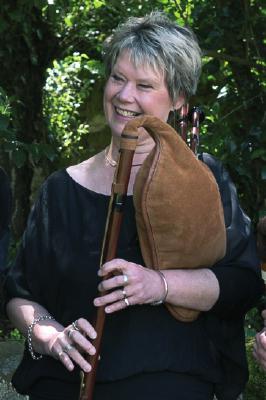
Another cornucopia of piping focused delights awaits in this Spring edition of Chanter. Staggeringly, I am now entering my ninth year as editor and it still amazes me how an edition can come together (sometimes a bit too close to the deadline for my own liking) and an unplanned theme emerges from the content. This time it’s all about research and making …. but they are all from completely different perspectives and experiences.
I am delighted that Tony Millyard has agreed to write up his account of his research and work on the Phagotum. This unique, early 16th century bagpipe is often referred to and often misquoted, partly through lazy research and partly through lack of knowledge and understanding. This research project, overseen by and developed with Eric Moulder at West Dean College, was undertaken around 20 years ago. Some members may remember his visit to the Blowout where he gave a fascinating talk about the Phagotum and it certainly created a lot of interest.
But his account has never been formally put into print and therefore onto a much bigger stage – where it truly deserves to be. I was privileged to witness the development process involving much head-scratching, contemplation, discussion and cogitations with various hypotheses being put forward about what this key did here, or what that line depicted there. Tony has also thrown out a challenge to take his work one stage further!
Paul Martin, a piper known to many a Blowout regular, is not only a superb musician but he is also turning into something of a maker too, albeit purely for his own ends. You may remember his experiments with elder pipes written up in Chanter in Summer, 2019. Making an instrument that exactly suits one’s own needs – and then having the ability to do it – is something to which I am sure many of aspire. Paul writes up his account of successfully developing a set of smallpipes. Next is an account of the personal journey and story of Russian pipe-maker, Alexander Anistratov. Again, we see how the desire to make and create can take someone down unintended pathways and the drive and focus that all makers seem to have to have. Alexander’s story also illustrates how, to achieve, the end, one has to overcome adversity and barriers. Alexander tells a fascinating and engaging story.
For those of a practical bent, and especially for those branching out into the exciting world of 3D printing, there are some very useful links from Thomas Ganter and his active forum. The forum is a very positive example of the creative and collaborative world of instrument making, with users sharing their knowledge and experience with others.
Whilst some pipes are made to fulfil a development and research itch, others for personal pleasure, the majority are made for sale to customers that the maker may never get to know. So it is particularly pleasing to read one such customer’s eulogy to her pipes. Siggy Parratt-Herbert opens up to the loves in her life.
Musician, researcher and writer, Merv Davey, gives us a fascinating In the Bag.
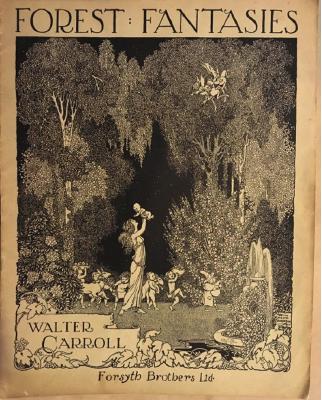
If playing the pipes is where you’re coming from, then there’s a treat from Dave Rowlands. I’m a fan of late 17th/early 18th century music and it’s great discovering pieces, usually composed for the violin, that can be adapted for pipes.
Dave also shares this love and he has transcribed many musical gems for pipes and I urge you to seek out his publications. Here he shares his research into Thomas Tollett. Tollett’s Hornpipe is a joy to play and definitely one of the tunes I enjoy playing most for pleasure, so it’s good to discover more from this composer.
Last, but definitely not least, details of this year’s Blowout are published.
Kirsten Baron has assembled an awesome lineup of musicians, teachers and workshops. If you can make the pilgrimage to Polesworth, this is definitely one year you won’t want to miss.
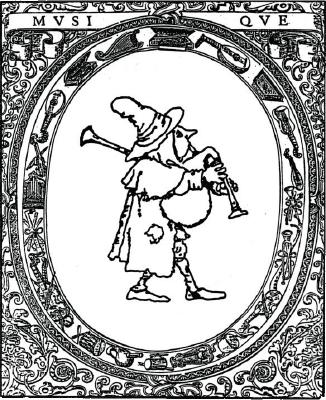
Dear Jane,
I have a copy of Forest Fantasies, a collection of 9 short pieces composed for solo piano by Walter Carroll in the early 20th century. The composer described the pieces as being ‘woven from the mysteries of fairyland, were inspired partly by the reading of Edmund Spencer's poems, and other elfin lore, but mainly by the memories of a lovely woodland glade nestling in a quiet corner of Galloway". The cover of the original sheet music was illustrated by Heath Robinson and contains an image of my favourite bagpiper. He looks as though he’s got a set of Jon Swayne’s renaissance pipes with a single drone. Long ago, I redrew the little fellow and I’ve just came across him! We're past 70 years since Heath Robinson died should be OK re ©.
Best wishes James Merryweather
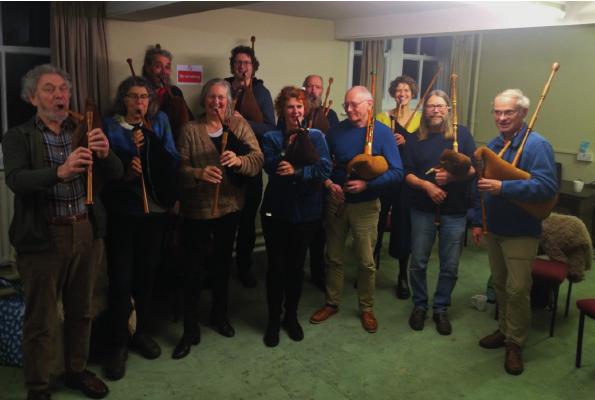
Hello, Thanks to The Bagpipe Society, and especially Jane Moulder and Aisling Holmes, for lending 8 sets of pipes for my Absolute Beginners Workshop in Holmfirth on the Blowzabella Workshop Day. We had a few who had never tried any kind of woodwind instrument.
Best wishes, Paul James
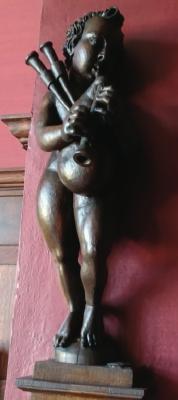
Dear Jane,
Having just read your 'Grace Notes' in Winter's
'Chanter' which I received today, I thought you might be interested in the attached photo which I took last summer in Hatfield House. The cherubic piper is a decorative finial on top of a staircase newel post.
Bagfully yours, David King
- Data Processing Notice (GDPR)
-
@BagpipeSociety on X (formally known as Twitter)
-
TheBagpipeSociety on Instagram
-
 BagpipeSociety on Facebook
BagpipeSociety on Facebook
Something wrong or missing from this page? Let us know!
